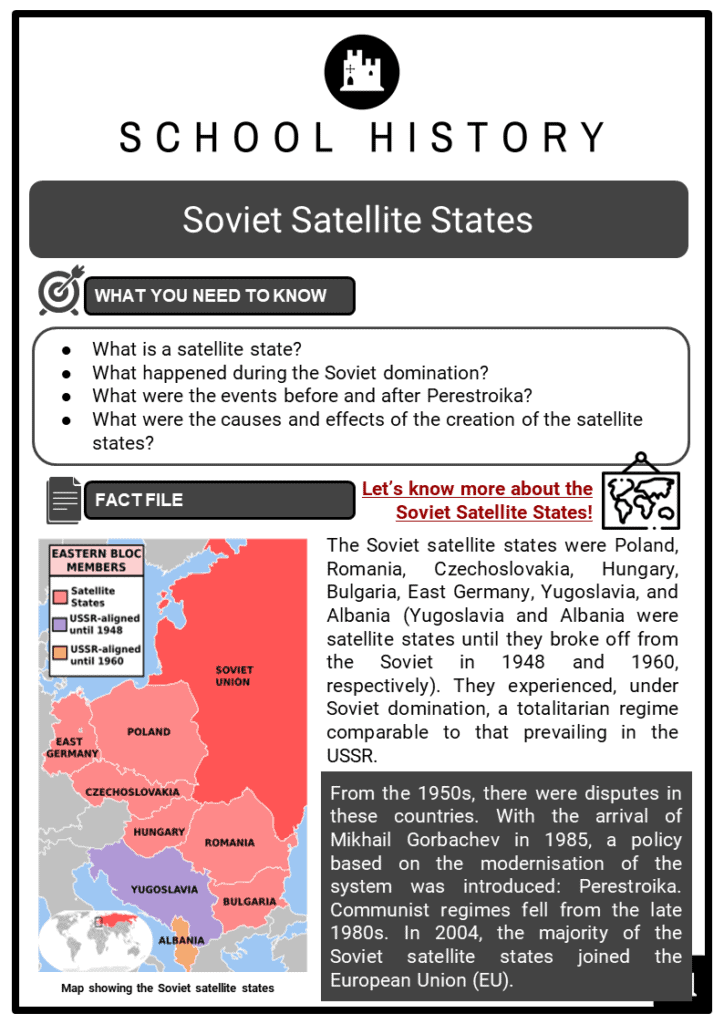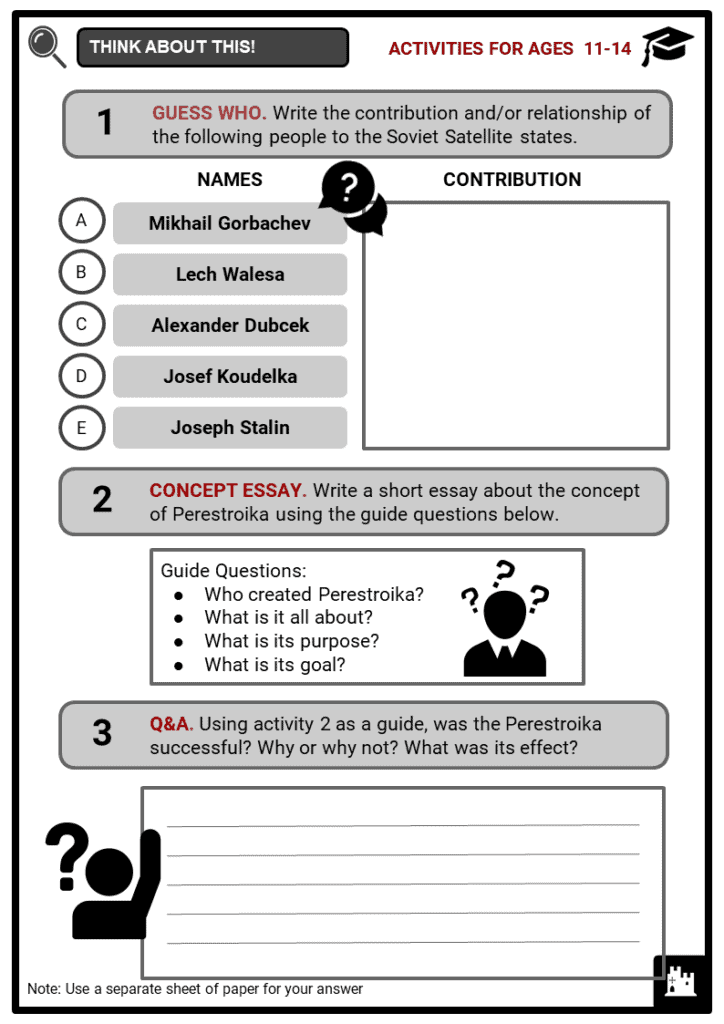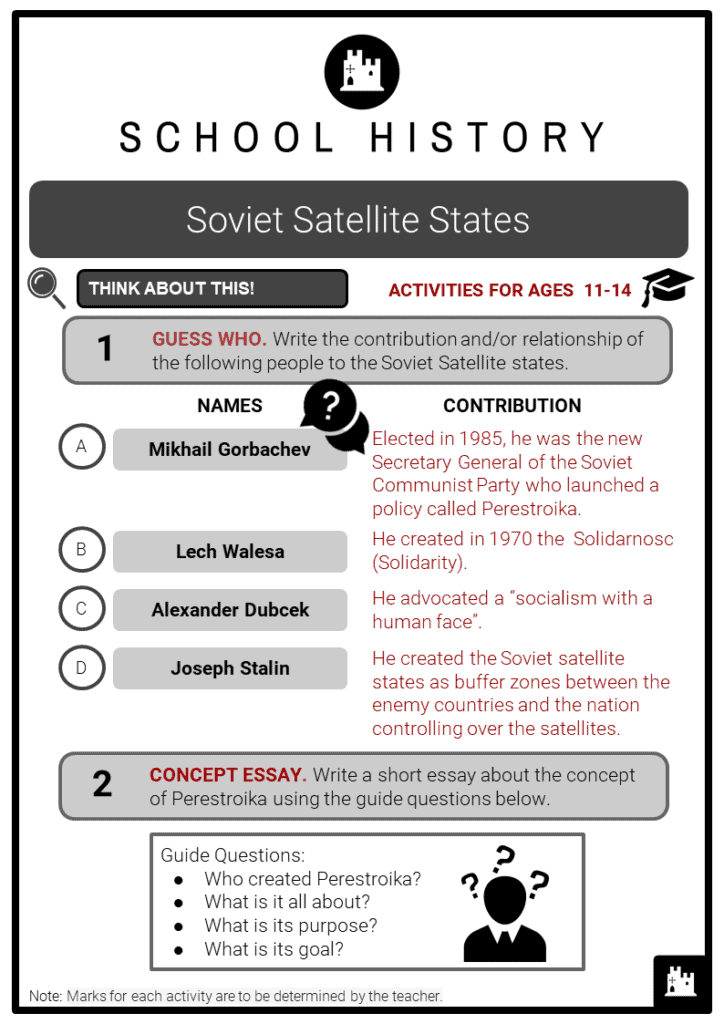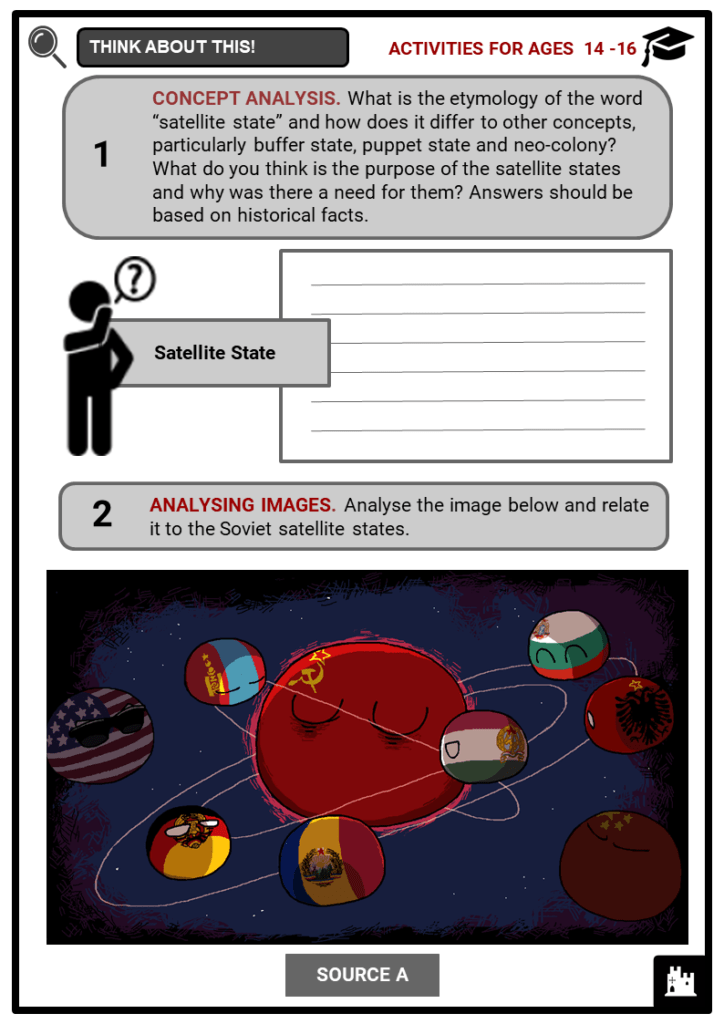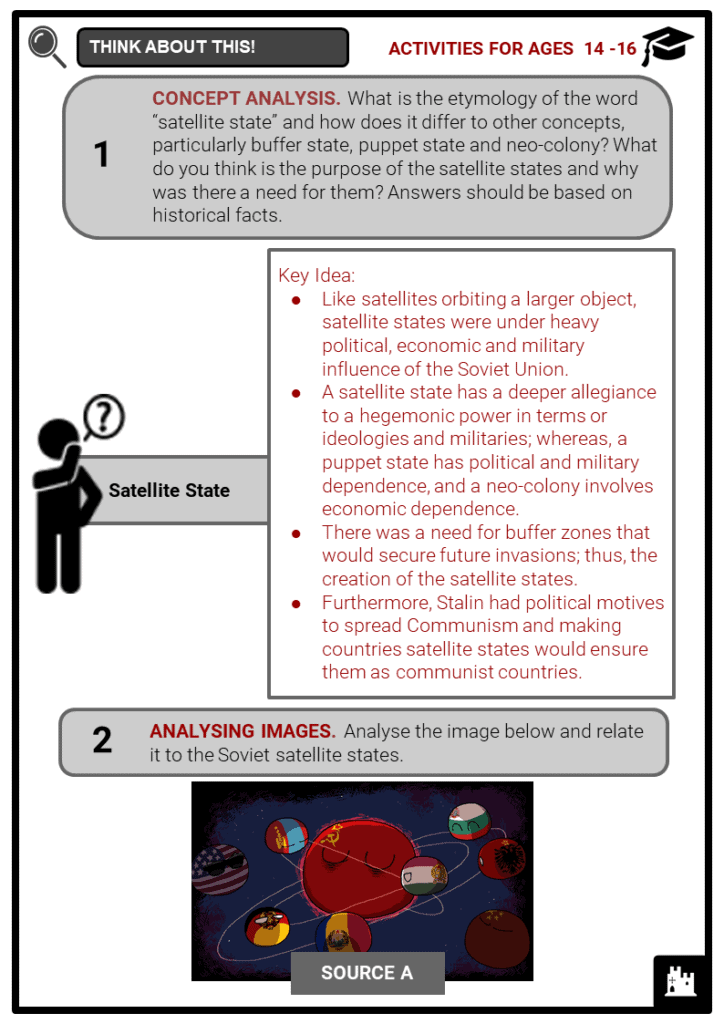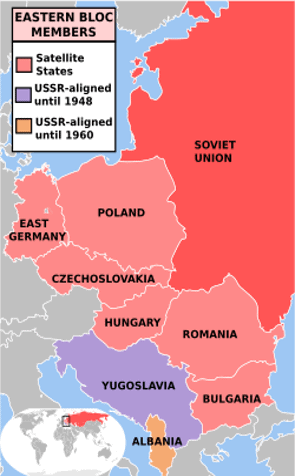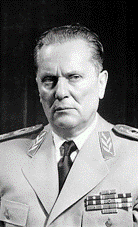Download Soviet Satellite States Worksheets
Do you want to save dozens of hours in time? Get your evenings and weekends back? Be able to teach Soviet Satellite States to your students?
Our worksheet bundle includes a fact file and printable worksheets and student activities. Perfect for both the classroom and homeschooling!
Table of Contents
Add a header to begin generating the table of contents
Summary
- What is a satellite state?
- What happened during the Soviet domination?
- What were the events before and after Perestroika?
- What were the causes and effects of the creation of the satellite states?
Key Facts And Information
Let’s know more about the Soviet Satellite States!
- The Soviet satellite states were Poland, Romania, Czechoslovakia, Hungary, Bulgaria, East Germany, Yugoslavia, and Albania (Yugoslavia and Albania were satellite states until they broke off from the Soviet in 1948 and 1960, respectively). They experienced, under Soviet domination, a totalitarian regime comparable to that prevailing in the USSR.
- From the 1950s, there were disputes in these countries. With the arrival of Mikhail Gorbachev in 1985, a policy based on the modernisation of the system was introduced: Perestroika. Communist regimes fell from the late 1980s. In 2004, the majority of the Soviet satellite states joined the European Union (EU).
“Satellite State”: Understanding the Word
- The word "satellite state" refers to a formally independent country, but under the influence and control of a larger country.
- Its name serves as an analogy to satellites orbiting a larger object.
- The word is sometimes confused with other terminologies such as "buffer state", "puppet state", and "neo-colony".
- The concept of a buffer state is part of the balance of power theory of the 18th-century European diplomatic thinking.
- It seeks a neutralist foreign policy that sets it aside from a satellite state.
- The concept of a puppet state (sometimes also called a puppet government or puppet regime) refers to a sovereign state whose affairs are advised by an outside authority.
- They are officially independent, however, subordinate by practice.
- Neo-colony, from the policy of neocolonialism, refers to a state under the political control of an outside power through dominance of its economy.
- This happens when a wealthy state extends its influence to a less developed state.
- A satellite state has a deeper allegiance to a hegemonic power in terms or ideologies and militaries; whereas, a puppet state has political and military dependence, and a neo-colony involves economic dependence.
- It is a fact that the countries of European Western society constituted one of the main lines of the capitalist West while the satellite countries presented one of the main (if not the main) lines of weakness of the Communist bloc.
- The hate and tension that existed between the Communist bloc and the Western countries was surprising.
- The Soviet Union had been experiencing multiple attacks, mainly from Germany in 1945, even though Germany and the Soviet signed economic and political pacts.
- Operation Barbarossa was the codename for the invasion of the Soviet Union that happened in 1941 during WWII.
- Though the operation failed, Joseph Stalin, who was then the leader of the Soviet Union, needed to act fast to be prepared for future invasions.
- It was then that Stalin created an empire that would serve as buffer zones for future invasions.
- These zones were basically states or countries in Eastern Europe which would later on be called “satellite states”.
- This empire included Poland, Romania, Czechoslovakia, Hungary, Bulgaria, East Germany, Yugoslavia and Albania. Although, the latter two countries have different cases.
- In 1948, Yugoslavia leader Josip Broz Tito had conflicts with Soviet leader Stalin.
- This resulted in the expulsion of Yugoslavia from the Communist Information Bureau, or Cominform.
- This event in history was called the Tito-Stalin or Yugoslav-Soviet split.
- In 1960, Albania, under the leadership of Enver Hoxha, also experienced conflicts with the Soviet Union.
- Their relations gradually deteriorated following the Soviet de-Stalinisation process.
- This event was referred to as the Soviet-Albanian split.
Soviet Domination
- These Soviet satellite states correspond geographically to a large part of Eastern Europe which was “liberated” and then occupied by the Red Army.
- The Soviets were gradually taking control of these countries: the Red Army occupied them and the Communist parties gradually eliminated the other political parties.
- From then on, the elections became perfectly formal, and without big stakes.
- This process spread between 1946 and 1948.
- It was in 1948 that the coup of Prague took place which saw the liberal President Benès forced to leave power.
- These countries rapidly applied the principles in force in the USSR: collectivisation of land and nationalisations of companies.
- An economic organisation, the Council for Mutual Economic Assistance (CMEA), also called COMECON, was created in 1949: it put “satellite” countries at the service of the Soviet economy.
- A military pact in 1955, the Warsaw Pact, was the counterpart of the North Atlantic Treaty Organization or NATO (Western military organisation around the United States).
- Moreover, through terrible purges and executions, these countries were experiencing a totalitarian regime comparable to that prevailing in the USSR.
Before and After Perestroika
- The Tito-Stalin split in 1948 became the first strain to the unity of the communist bloc.
- When Joseph Stalin died in March 1953, some hoped for the fall of the USSR. The Hungarian revolt of 1956 was brutally crushed (November 1956), as was the 1953 East Berlin workers’ uprising.
- The construction of the Berlin Wall in August 1961 showed how rigid the political situation remained.
- In 1968, the challenge this time was on the side of Czechoslovakia.
- Liberal Alexander Dubcek was at the forefront.
- He advocated a “socialism with a human face”.
- But his revolt against Soviet domination would also be repressed after the arrival of Warsaw Pact troops on Czech territory.
- On this theme, we can particularly look at the photographs of Josef Koudelka.
- The initiative would come from Poland, with the creation in the 1970s of Solidarnosc (Solidarity) by Lech Walesa.
- The election of Polish John Paul II as the new Pope in Rome in 1978 gave additional energy to this protest movement.
- This movement had a great echo in the West.
- Elected in 1985, Mikhail Gorbachev, the new Secretary General of the Soviet Communist Party, launched a policy called Perestroika (Russian for “restructuring”).
- He intended to save the economic system by modernising it. The goal of Perestroika was not to end command economy, rather to incorporate socialism to society and make it work.
- At the end of the 1980s, one after another, the communist regimes fell, Hungary in 1989-1990 and Germany a little after the fall of the Berlin Wall on 9 November, 1989.
- The democratic regimes that succeeded these dictatorships, however, had difficulty in imposing themselves.
- Throughout the 1990s, we saw the communist parties continue and liberal parties impose economic modernisation measures that the people often found it difficult to live by.
- Yet in 2004, the majority of these countries joined the EU, taking up a place in the heart of Europe that their forced subjection to the USSR had made them lose.
- The Perestroika that was ironically created for the economy of the Soviet Union, became the cause of the dismemberment of the Union itself.
Causes and Effects of the Creation of Soviet Satellite States
CAUSES
- The Soviet Union had a desire for more territory and security that it wanted to expand its influence around Eastern Europe.
- When the Soviet Union suffered from being invaded twice by Germany, one in 1914 and again in 1941, Joseph Stalin created the Soviet satellite states as buffer zones between the enemy country and the controlling nation over the satellites. This is in preparation for future invasions.
- Another cause for its creation may be for the spread communism.
EFFECTS
- The Soviet Union, after the creation of the satellite states, now had complete control over Eastern Europe. This created the separation between East and West (as expressed in Winston Churchill's "Iron Curtain").
- Although the satellite states secured the Soviet Union as they were now able to act as buffer zones for future invasions, increased rivalry and distrust rose among the USA, Britain, and France that believed Stalin's motives were political.
- They thought that the satellites were a way to expand Soviet views on communism which was contrary to the East's views on capitalism (as suggested in the Cold War).
Image sources:

